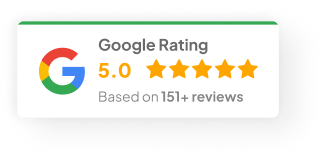03 Oct 25
Real Estate Web Design Secrets That Get Buyers to Click, Call, and Commit
The real estate market’s crowded. Buyers scroll through page after page of listings, and sellers want results yesterday. In that kind of pressure, your website isn’t just some digital business card. It’s the engine that either drives your business—or stalls it.
If a site doesn’t convert, it’s basically sending people straight to the competitor down the street. The question is, what makes a site that buyers stick with instead of bouncing in five seconds flat? Let’s get into the design moves that actually matter.
1) First Impressions Happen Fast
People decide if they like a site in the blink of an eye. Google says it’s about 50 milliseconds—that’s literally faster than it takes to snap your fingers.
For real estate, that first impression is everything. Messy layout, dull colors, low-res photos? That can quietly signal to buyers, maybe this agent isn’t detail-oriented enough for my biggest investment. On the other hand, clean navigation, sharp branding, professional property photos—those send the right message from the start.
A few quick wins here:
- High-quality property images (no blurry phone shots)
- Clear and simple menu structure
- Consistent fonts, colors, and branding
2) Mobile Isn’t Optional Anymore
Most buyers are house-hunting on the go. Report says 76% found their home on a mobile device in 2023. That’s three out of four.
So if a site looks great on desktop but falls apart on a phone, that’s a problem. Responsive design isn’t just “nice to have.” It’s the difference between a buyer scheduling a showing—or giving up because the page won’t load. And honestly, frustrated buyers don’t call. They just move on.
3) Show Properties the Right Way
No one wants to read a wall of text about a property. They want to see it. Feel it.
That’s where smart visuals come in:
- Professional, high-res photos = higher perceived value
- Video tours = 403% more inquiries than plain listings
- Virtual staging = helps buyers imagine themselves in the space
Good visuals don’t just show a house. They pull buyers into the experience—and that emotional connection is what gets them to take the next step.
4) Clear Calls-to-Action
Every page needs to nudge visitors somewhere. The problem is, too many real estate sites hide their CTAs in clutter.
Strong CTAs are easy to spot, direct, and placed right where the user’s thinking about acting. Buttons like Book a Tour or Get Property Alerts work because they’re short and clear. Place them after property details, next to testimonials, even at the bottom of a blog.
When the “what’s next” is obvious, people actually click.
5) Local SEO Built Into Design
Pretty sites that don’t show up in search aren’t worth much. Buyers type things like homes for sale in Denver or real estate agent near me. If the site isn’t structured for local SEO, it may never show up in those results.
Some basics that make a big difference:
- Titles and meta descriptions with local keywords
- Landing pages for neighborhoods or property types
- Google Maps embedded for quick directions
Good design and good SEO aren’t separate—they work hand in hand.
6) Trust Builders: Testimonials & Reviews
Buying or selling a home is personal, emotional, and a big financial leap. Visitors want to know they’re dealing with someone trustworthy. That’s where testimonials, reviews, and social proof come in.
BrightLocal found 46% of consumers trust online reviews as much as a recommendation from a friend. So, a page full of client stories, or even sprinkling reviews across the site, can be the nudge that gets someone to pick up the phone.
7) Keep the Journey Simple
Overcomplicated sites kill interest fast. Pop-ups everywhere, clunky filters, outdated menus—it all creates friction. And buyers don’t have patience for friction.
The smoothest sites usually follow a simple path:
- Homepage: Featured listings and search right up front
- Listings page: Easy filters, clean photos, quick contact button
- About page: Who you are, why you’re credible
- Contact page: Short form, clickable phone, office map
Strip away the noise, and it becomes easy for buyers to move from browsing to booking.
8) Track What Works (and What Doesn’t)
Websites aren’t “set and forget.” The best ones are refined over time with data. Tracking things like where users click, how long they stay on a page, and which CTAs get ignored is how smart real estate sites improve.
Heat maps, for example, show exactly what parts of a listing keep attention. If no one’s clicking on a certain button, maybe it’s the wrong wording or in the wrong spot. The point is, design decisions shouldn’t be guesses—they should be backed by behavior.
Why Chromatix?
At Chromatix, the focus has always been on sites that convert. Not just pretty layouts, but websites that turn clicks into calls. That’s what keeps clients coming back.
Real estate in particular needs a different approach than, say, e-commerce or corporate services. Luxury homes, first-time buyers, commercial spaces—each one needs its own flow. That’s why templates don’t cut it. Every project is tailored for the audience it’s trying to reach.
And it’s not just real estate. Chromatix has delivered across industries, always applying the same principles: clarity, trust, and design that drives results.
Bottom Line
Real estate’s competitive. Sellers want results fast. Buyers want a smooth, engaging experience. The right website design can bridge both.
Quick recap:
- Nail first impressions
- Go mobile-first
- Invest in strong visuals
- Use clear CTAs
- Build local SEO into the site
- Track and refine with analytics
Do all that, and the website stops being just a brochure. It becomes the best sales tool on the table.
Chromatix has been doing this for years—and the proof is in the results. If the goal is to turn site visits into real leads, this is the place to start.


